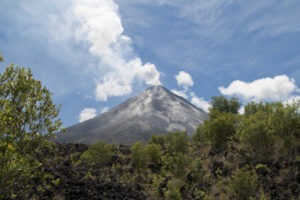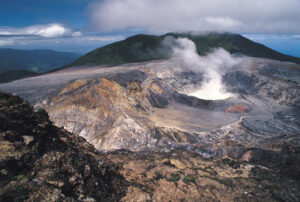

Gerwin Filius/Getty Images
Arenal Volcano, Costa Rica
Have you ever seen or visited a volcano? Costa Rica is home to more than 200 volcanic formations, but only five are classified as active. The countless volcanic eruptions over thousands of years have played a key role in creating Costa Rica’s fertile soil. This rich soil, in turn, contributes to the country’s lush forests, making Costa Rica a haven for a thriving diversity of wildlife and plant life. Two of the most interesting active volcanoes are the Poás Volcano and the Arenal Volcano.
The Poás Volcano in central Costa Rica is about thirty miles northwest of San José. Two very different craters rest atop this beautiful mountain. The crater on the northern side is called Laguna Caliente. Can you guess why? At the bottom of this crater, which is about one mile wide and 900 feet deep, is a lagoon that spits out boiling sulphurous gases. It has erupted over forty times since 1828, and shows no signs of stopping soon. It is also one of the world’s most acidic lakes, with a pH of almost zero—not exactly meant for swimming or aquatic life! On the other hand, the southern crater, Laguna Botos, is inactive and is filled with ice-cold, clear water that flows down the volcano into the Sarapiquí River. The Poás Volcano is part of Poás Volcano National Park, with its lush tropical forests. The park shows off Costa Rica’s incredible biodiversity. If you think you see a green-yellow squirrel in the park, don’t clean your glasses—this is the only place in the world where you will see the Poás green-yellow squirrel!
An even more active, must-see volcano in Costa Rica is the Arenal Volcano, a cone-shaped volcano about ninety-one miles from San Jose. It is one of the most active volcanoes in the world. Visitors can feel underground rumblings and view explosions of ash rising into the sky above and glowing orange lava rocks crashing down the mountain. If you like dramatic, awe-inspiring spectacles, view the volcano at night when it offers a breathtaking display of light and explosions, turning the night sky a glowing deep red! The volcano rises from the middle of Arenal Volcano National Park, towering above Lago Arenal, a reservoir whose water is used for hydroelectric power.

GOODSHOOT/Alamy
Poás Volcano, Costa Rica
Besides their incredible natural beauty and fascinating histories, the volcanoes and their surrounding national parks serve as fabulous recreational areas for such activities as hiking, swimming, white-water rafting, fishing, camping, horseback riding, adventurous exploring, and observing all kinds of fabulous flora, fauna, and birds.
Explore More:
1. How many volcanoes do you think exist in the United States? Can you name some of them? How many are considered active? In what areas would you find most of the volcanoes in the United States? When and where did the most recent eruption take place? You can learn all these answers, as well as view amazing images on the U.S. Geological Survey (USGS) Web site.
2. What is the Pacific Ring of Fire? Explore this huge area of volcanic and seismic activity that includes both the volcanoes in the United States and the volcanoes in Costa Rica. How far does this area stretch, and what is its significance?
3. Investigate the other active volcanoes in Costa Rica not mentioned in the article.
Share What You Know:
Have you studied volcanoes in science class? Did you construct your own volcano? If so, explain your project or what you learned about volcanoes to the class.